-
Membership
Membership
Anyone with an interest in the history of the built environment is welcome to join the Society of Architectural Historians -
Conferences
Conferences
SAH Annual International Conferences bring members together for scholarly exchange and networking -
Publications
Publications
Through print and digital publications, SAH documents the history of the built environment and disseminates scholarshipLatest Issue:

-
Programs
Programs
SAH promotes meaningful engagement with the history of the built environment through its programsMember Programs
-
Jobs & Opportunities
Jobs & Opportunities
SAH provides resources, fellowships, and grants to help further your career and professional life -
Support
Support
We invite you to support the educational mission of SAH by making a gift, becoming a member, or volunteering -
About
About
SAH promotes the study, interpretation, and conservation of the built environment worldwide for the benefit of all
Scaffolding and a City in Section: An Introduction to La Habana
Danielle S. Willkens is the 2015 recipient of the H. Allen Brooks Travelling Fellowship. All photographs and videos are by the author, unless otherwise noted.
It is an understatement to say that it is an interesting time to be in Cuba. As an architectural designer and historian studying the impact of tourism, Havana has been a complex, and at times confounding, classroom. In just the last thirty days, the length of a traditional tourist visa, record numbers of Americans have toured the capital, the first commercial flights from the United States landed in Havana since the two nations restored diplomatic relations after fifty-five years of silence, and the Cuban news stations extensively covered both an election that may impact renewed dialogues and the death of Fidel Castro (Figures 1 and 2).1 The paint on street murals commemorating Castro’s 90th birthday is barely three months old but, as I write, the nation is enduring a nine-day period of morning as the ashes of the Revolution’s leader travel through the nation en route to their final resting place in Santa Ifignia cemetery, to be interred alongside other prominent figures from the nation’s history.

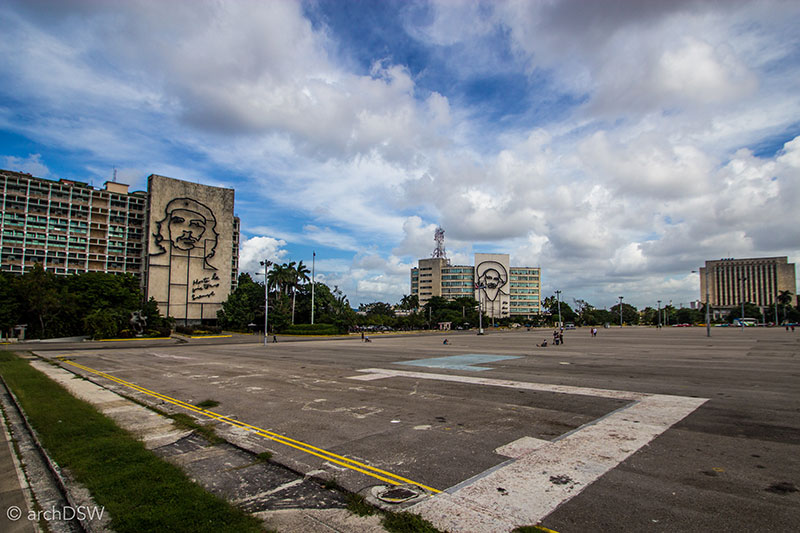
Figures 1 and 2. Located in the Plaza de la Revolución, originally named Plaza de la República under Batista, the Ministerio del Interior (1953) by Aquiles Capablanca is arguably one of the most photographed buildings in Havana, not for its Corbusian form but, instead, for the large, steel sculpture of Che Guevara. Based on the famous photograph by Alberto Korda from 1960, the portrait is accompanied with the phrase “Hasta la Victoria Siempre” [Always Toward Victory]. A similar, continuous contour steel sculpture was added to the nearby telecommunications building. Often mistakenly identified by tourists as an image of Fidel Castro because of the phrase “Vas Bien Fidel” [You're going well, Fidel] beneath the portrait, the sculpture features another revolutionary figure, Camilo Cienguegos.
Besides the current uncertainty and imposed disruptions to businesses, transportation, and even baseball schedules in the nation, moving from the cold, volcanic landscapes of the Scandinavian nations of Iceland and the Faroe Islands in the North Atlantic to a Caribbean nation ruled by the Communist Party of Cuba proved to be a challenge in many ways. Heavy coats and hats were traded for linen shirts. The sunglasses that I barely used in Iceland became invaluable in Havana. While in transition between islands, I prepared for site navigation and maintaining correspondence without the assistance of easily accessible wireless data and I changed several of my working methods for documentation during my travels. Although Cuba is geographically the closest to my home in Auburn, Alabama, it is logistically and technologically the most different from any of the sites I will be visiting during my research sponsored by the H. Allen Brooks Traveling Fellowship. Having no desire to repeat the errors of a Canadian man who illegally flew a drone in Havana, and consequentially spent eleven days in a Cuban detention center, I left my carefully packed UAV in the United States. In addition to the fact that the entire island of Cuba is a ‘no fly zone,’ the nation also has more strict regulations for handheld cameras, especially in select museums and around governmental buildings. During my first days in Havana I discovered that DSLR cameras were not welcome in certain public spaces or state-run businesses either. In contrast, in most museums and residential areas, the guides and residents were happy to welcome photographs, especially for visitors who displayed a keen interest in architecture.
As the first post in a series on Cuba, this month’s blog serves as an introduction to the capital city of Havana where there is a rapidly developing tourist infrastructure working in partnership with restoration programs that celebrate the unique language associated with Cuban architecture and urban life (Figures 3–6).

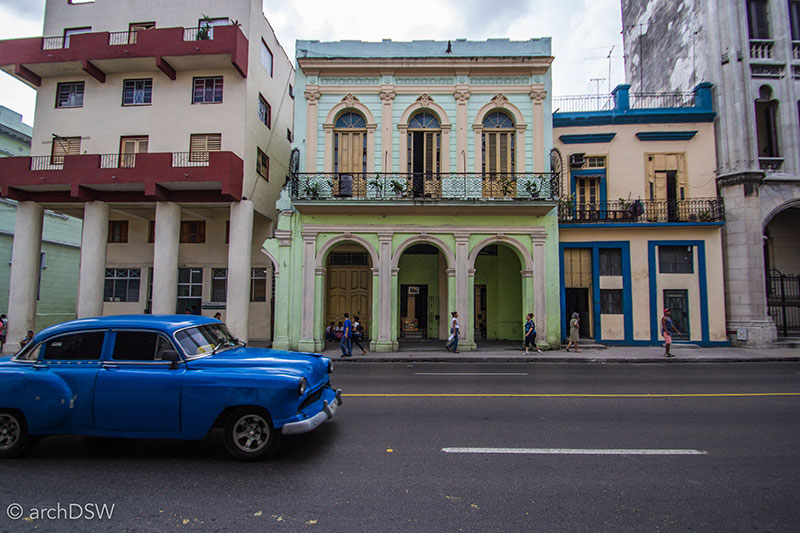
Figures 3 and 4. Street scenes along in Avenue Simón Bolívar in Central Havana, featuring the capital’s signature combination of eclectic architectural patina and classic cars.
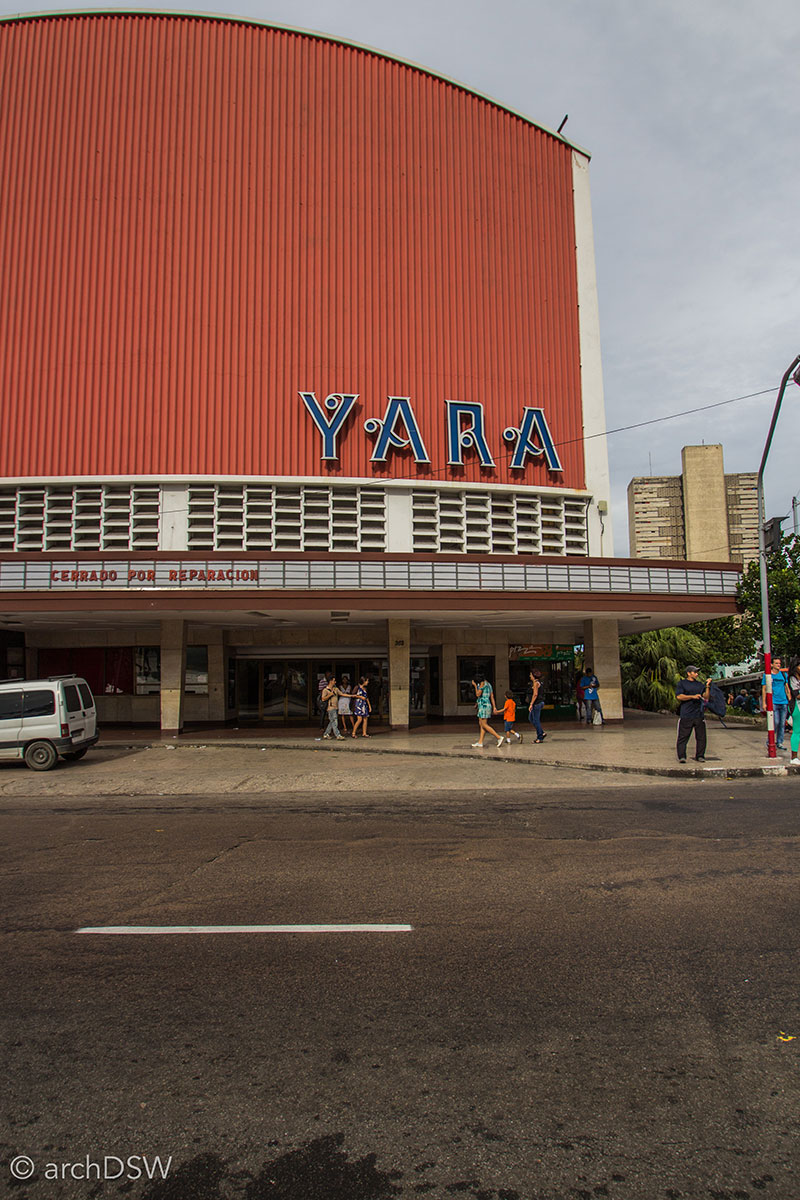
Figure 5. On cultural and entertainment sites around the capital, it was common to see signs declaring ‘cerrado por reparación’ [closed for repairs], such as the marquee on the Radiocentro Building [Yara Cinema], designed by Junce, Gastón and Dominguez between (1945–1947) along La Rampa in Vedado.
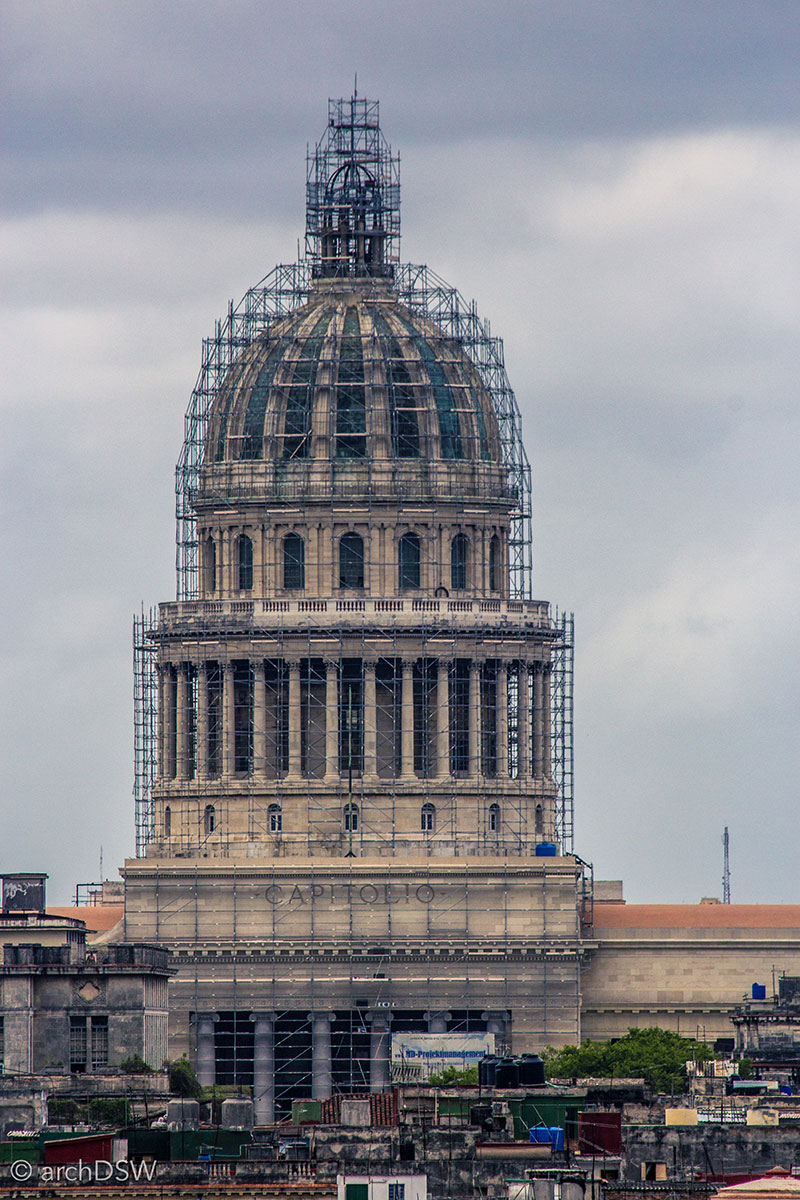
Figure 6. A view of the scaffolding covering the dome of the Capitolio. A major restoration effort for the Capitolio (1926–1929) began in 2010 and is expected to continue through 2017.
A Capital of Tourism
In many senses, Havana has always been a center for tourists and transient visitors. Founded in 1519 and named after the patron saint of travelers, San Cristóbal de La Habana served as a critical site for the Spanish Empire in the New World. Other European nations, and pirates, quickly recognized the strategic location of the harbor in the Caribbean so Havana was strongly fortified in the 16th and 17th centuries through the construction of El Castillo de la Real Fuerza, El Castillo de San Salvador de la Punta, El Castillo de los Tres Reyes del Morro, and a series of city walls that, although now largely dismantled and in ruins, demarcate La Habana Vieja and define the capital’s designated World Heritage Site (Figures 7–12).
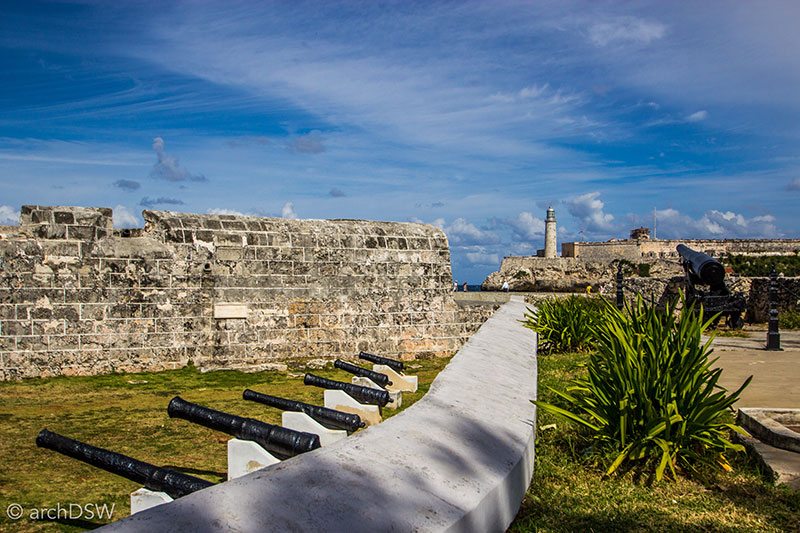
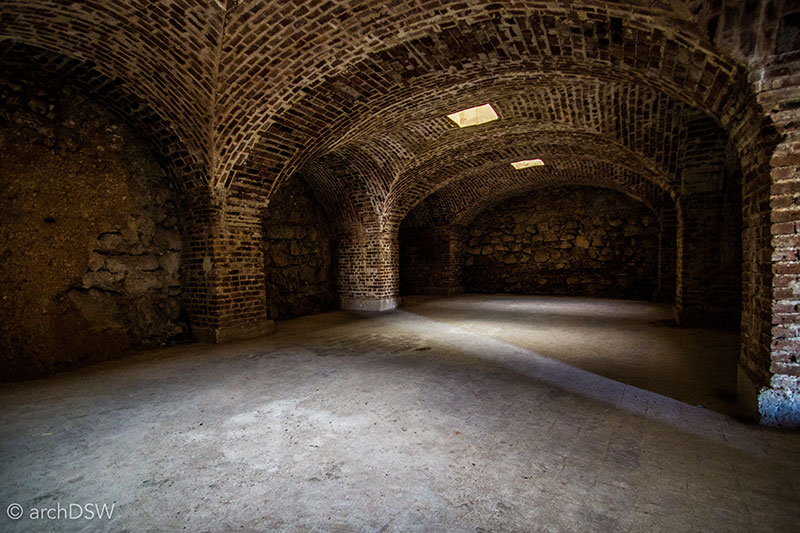
Figure 7 and 8. Views of sea frontage and vaults in a munitions room of the recently restored El Castillo de San Salvador de la Punta.

Figure 9. A view through one of the turret apertures of El Castillo de San Salvador de la Punta, looking towards the Malecón and the towers of ‘new Havana’.



Figures 10-12. Upturned canons and cannonballs branded with the logo of the Office of the Historian in the City of Havana now mark pedestrianized streets and define boundaries within several plazas of La Haban Vieja. According to the numerous signs posted around the old city’s construction projects, revenue in many of Old Havana’s businesses supports restoration efforts in the neighborhood.
During the 1920s Havana was a popular site for Americans who were escaping prohibition and in search of entertainment and gambling venues in a lush, historic landscape that was, simultaneously, embracing emerging trends in design and technology. By the 1950s, commercial flights made Havana an economical getaway for Americans but visitor numbers declined drastically with rising, revolutionary violence in 1957. Diplomatic relations between the United States and Cuba were restored in December 2014. Although this détente is proving to be economically beneficial, the rapid rise in visitors may strain the already fragile infrastructure and built fabric of the city. In 2015, more than 3.1 million people visited Cuba and visitor numbers for 2016 are on track to beat 2015’s groundbreaking figures by more than 15%.2 In addition to the lessened restrictions for American travelers, the rise in international visitors can be attributed to several policies instigated by Raúl Castro in 2011 that are helping to reshape the capital by opening paths for entrepreneurial ventures, such as a the paladares [restaurants in private houses] that are opening across the city. With a rise in speculative development, the number of new and adaptive reuse projects is soaring in the city, thereby offering Cuban architects the first opportunities since 1959 for design commissions outside of the realm of state-sponsored architecture. This is inaugurating a new era of Cuban architectural regionalism. For example, Habana Re-Generación has initiated commercial, residential, and even industrial regeneration projects, such as the installations placed within the abandoned Tallapiedra (1915–1940) electric plant in conjunction with the 12th Havana Biennial, and through grassroots efforts, artists are transforming houses and former factories into working spaces, galleries, and some of the most compelling music venues in the city.
With the rise of visitors to the island, the capital city faces some challenges in relation to the bifurcation of services for locals and tourists. For example, in several residential portions of the city, power is restricted from 8 a.m. until 5 p.m. but those staying in hotels and select casa particulars [private homestays] never perceive this interruption. The comforts of air conditioning, hot water, and mechanically flushing toilets can be found in the vast majority of hotels; new constructions, such as those sponsored by the Spanish chain Iberostar, even feature perfumed HVAC systems akin to those found in sites like the casino-resorts of Las Vegas (Figures 13 and 14).

Figure 13. A panoramic view looking south, towards the Capitolio and Parque Central, and north along the Paseo de Marti.

Figure 14. A panoramic view from Hotel Parque Central, overlooking a portion of Central Havana to the west of the Paseo de Marti and pedestrian park known as the Paseo del Prado, known simply as the Prado. Captured just a few blocks north of the photograph from Figure 13, this panorama shows the dilapidated character of residences in Central Habana in contrast to the recent flood of restoration projects around the Capitolio and La Habana Vieja.
During my first weeks in Havana, I had repeated experiences that underscored that the capital city of Cuba is divided into a distinct series of sections. These ‘sections’ seem to invade most aspects of the city, ranging from the overall organization of the capital to aspects of tourism, social structure, infrastructure, and architecture. As the largest of Cuba’s provinces, Havana is further subdivided into fifteen municipalities: La Habana Vieja (Old Havana), Centro Habana, Plaza de la Revolución (including Vedado), Playa (including Miramar), Cerro, Diez de Octubre, La Lisa, Marianano, Boyeros, Arroyó Naranjo, San Miguel del Padrón, Cotorro, Regla (including Casablanca), Guanabacoa, and La Habana del Este (Video 1).
Video 1. Scenes from the Havana tour bus, traveling through La Habana Vieja, Vedado, Playa, and Miramar.
The physical and social strata of servant and served that once defined Cuba’s pre-independence and pre-revolutionary eras has transitioned into the separation of the locals from the tourists. In almost every situation, the services and spaces reserved for tourists are different than those for Havana residents. This is most noticeable in the use of two different currencies: the national Cuban peso (CUP) and the convertible peso (CUC), equal to approximately 24 CUP. Cubans use both currencies, but the CUP is mainly related to state-sponsored services (e.g. electricity bills) and familiar trade exchanges, such as the fruit and vegetable markets. While Cubans patiently wait in line to use the Havana’s banks, tourists are offered the convenience of cambia within the lobbies of most hotels and few ever complete transactions with CUP (Figures 15–17).

Figure 15. The twenty-one-story hotel now named Habana Libre (1958), originally constructed as the Habana Hilton Hotel by Welton Becket and Associates, is one of the most recognizable landmarks in the city. Occupying an entire block, the building navigates the site’s steep slope with the integration of shops, a restaurant, and a cafeteria into the ground story.

Figure 16. A view from the Fosca building over the parabolic arch roof of the Radiocentro Building and towards the intersection of Calle 23 and L. Captured in 1954, this photograph shows the future site of the Habana Hilton being cleared for construction. From the University of Havana archives, collection #28039.
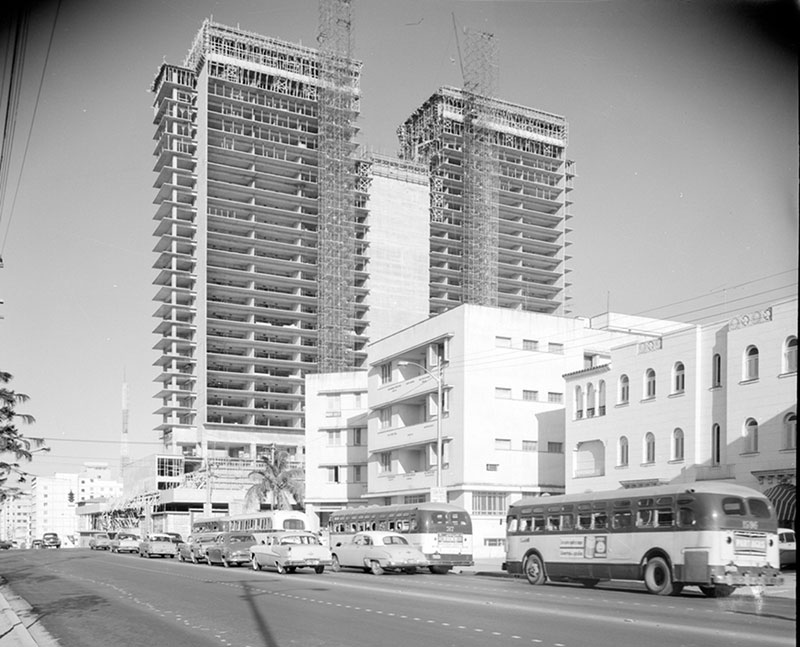
Figure 17. A view of the Habana Hilton under construction, captured on February 15, 1957. From the University of Havana archives, collection #37493.
For tourists, hotels also provide sheltered and more convenient access to Wi-Fi, albeit slow and unreliable. However locals must wait, once again, at the offices of the governmental agency of ETECSA (Empresa de Telecomunicacions de Cuba S.A.) where an hour queue can result in the discovery that the office is entirely out of the Wi-Fi access cards, sold in increments of either one or five hours. When cards are available from the office or entrepreneurial resellers, locals and intrepid visitors can use the WI-FI hotspots scattered in the parks and urban plazas around the capital.
For visitors who stay in Havana’s hotels, these complexes become inclusive nodes for services and transportation. Havana’s famous combination of pre-1960s American cars, mixed with various Soviet designs and, recently, the introduction of kit cars, serve the hotels and it is often easy to spot a tourist area in the city by the number of brightly colored convertibles parked on adjacent streets. Observing lobbies and urban life around hotels, it is clear that many tour groups board hired transport, typically well maintained and air conditioned buses, at their hotel’s port cochère and return to the same place, rarely getting a glimpse of the city by foot (Figures 18–20). This drive-by mentality means that they miss Havana’s vibrant street life as well as the opportunity to experience the other modes of transportation such as the local buses, Cocotaxis, or the ‘cooperative taxis’ that run in grids across the city and were only recently made available to the island’s visitors (Video 2).

Figure 18. Seen from the Malecón, Hotel Nacional de Cuba (1930) was designed by McKim, Mead and White as a grand, eclectic resort that affords visitors a tranquil, walled landscape with views to the sea and manicured grounds, complete with an ostentation of peacocks.

Figure 19. Situated along the Malecón and originally funded by Meyer Lansky, the designs for the Habana Riviera Hotel (1957) were originally by Philip Johnson but Miami hotel architect Igor B. Polevitzky eventually replaced Johnson on the project. Today the hotel is an anchor for American taxis on the western end of the Malecón.

Figure 20. Vibrant lime paint coats the new buildings of the Hotel Comodoro Habana resort complex in Ciudad de la Habana. Like many of the new construction projects along Cuba’s coast, the buildings are affixed with solar hot water heaters for guest rooms.
Video 2. A bumpy, but entertaining, ride on a Cocotaxi through a portion of Vedado.
Although the divisions in services for tourists and residents are striking, there are select visitors to the capital that operate between these two worlds: select people-to-people groups who liaise with locals on a daily basis, independent travelers and researchers who live in casa particulares, and various foreign students. At the University of Havana, study abroad students take classes [in Spanish] alongside Cubans and for the past thirty years, students of all ages and diverse nationalities have studied with the Faculty of Spanish for Non-native Speakers (FENHI) (Figures 21–24). Between breaks from daily classes, they visit local cafeterias and traverse the areas around the university that are foreign to most visitors: steep, tree-lined streets, bordered by winding retaining walls and imposing neoclassical structures that comprise entire blocks. It is easy to imagine a time when these neo-Renaissance mansions were once in pristine condition, filled with lush gardens and the highly divided spatial strata related to service and the served. Today, many of the homes are in disrepair, either entirely crumbling or existing in some form of patchwork since the grand salons were carved into apartments, with the porches and arcades that now house café kiosks and hanging laundry. Other homes, however, have been maintained or restored under the care of the university or a private institution, such as the Museo Napoleanico that will be explored in a future post on museum culture on the island.
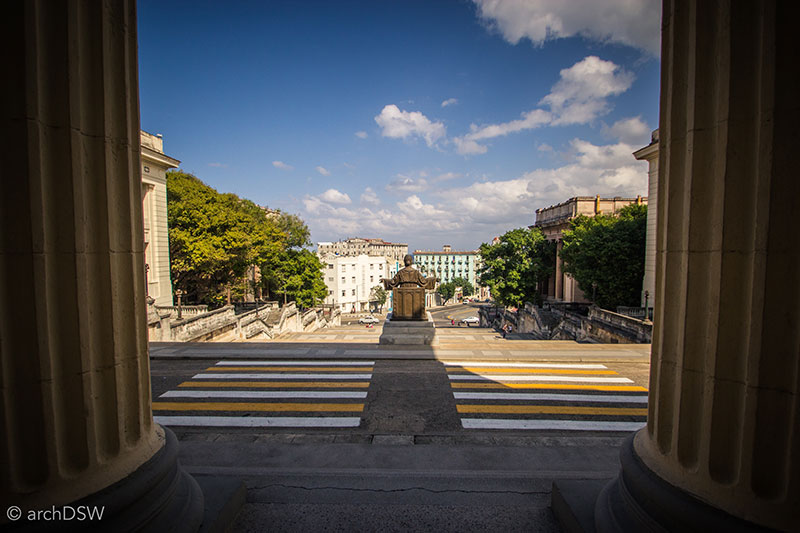
Figure 21. The grand entry to the main campus of the University of Havana is located at the intersection of San Lázaro and L Streets. Although this campus is the historic core of the university, there are more than fifty-two academic and support buildings scattered around the capital’s municipalities.
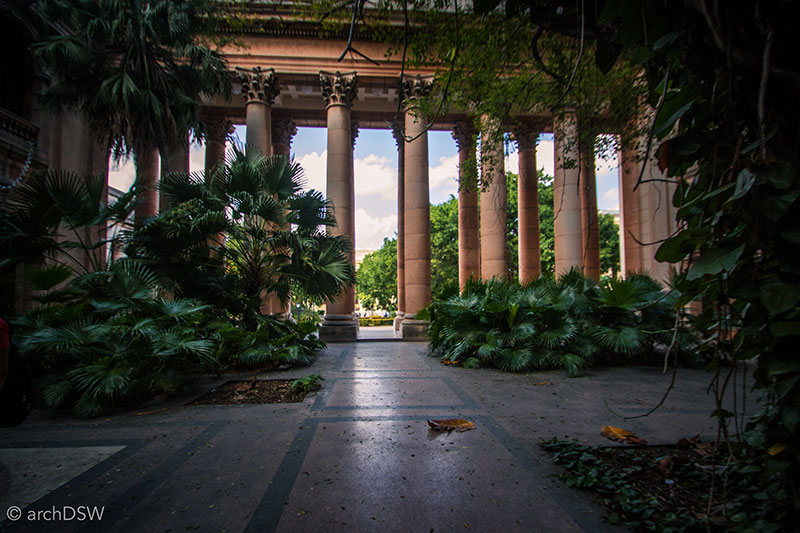
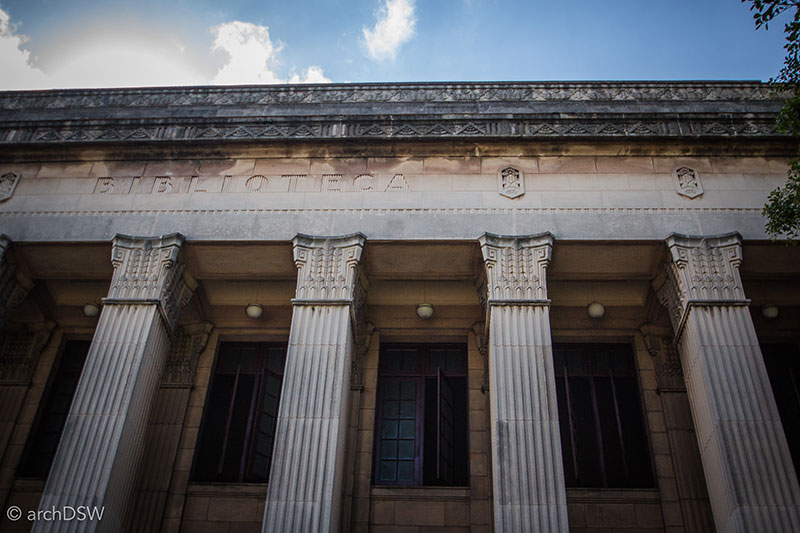
Figures 22 and 23. Like the rest of Havana, the main campus features several architectural styles, ranging from neoclassical to eclectic. With the exception of the oldest structure on the campus, reserved for large lectures and ceremonies, the campus and buildings of the university are open to locals and visitors.
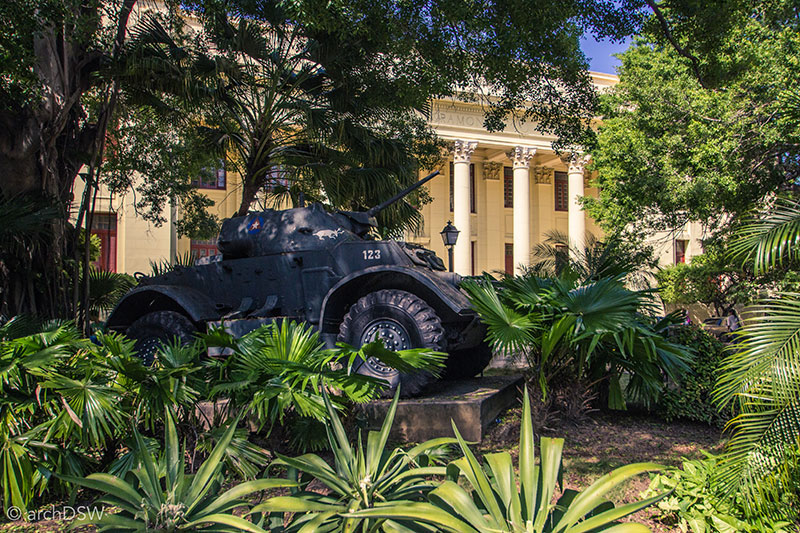
Figure 24.There are a number of statues, monuments, and art pieces scattered around the main campus, commemorating the university's roll in the fight for independence and the Revolution, including an armed owl, referencing the green-eyed icon in the historic tympanum of the main building (essentially a propylaea for the campus) and tank used during the Revolution.
Architectural Language[s] of Havana
As previously mentioned, Havana is an architectural classroom, filled with the Spanish colonial legacy of the mid-16th through late 19th centuries: colorful examples of neoclassicism, eclecticism, Art Nouveau, and Art Deco. These structures sit in stark contrast to modern hotels and urban developments of the twentieth century. In most parts of the city, arcades provide a welcome place to escape the sun and serve as unifying features for the diverse architectural landscape of each urban block. Other features, many unique to Cuban architecture, can be found across styles. Materials and details are manipulated to make form-appropriate applications for residences and smaller-scale commercial structures: entresuelo [mixed use balconies], guadevecinos [balcony dividers], guardapolvo [small eaves over doors and windows], persianas [brise-soleil], rejas [grilles], and vitrales [stained glass transoms] (Figures 25–30).


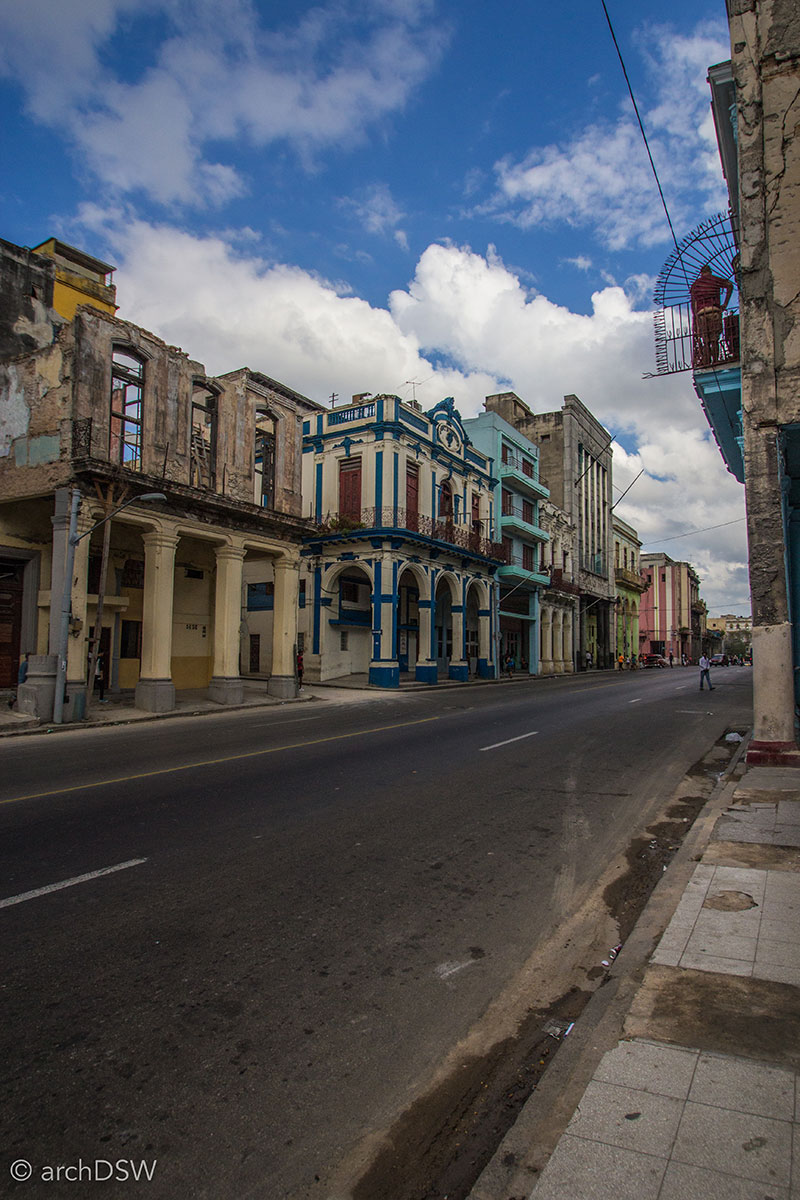
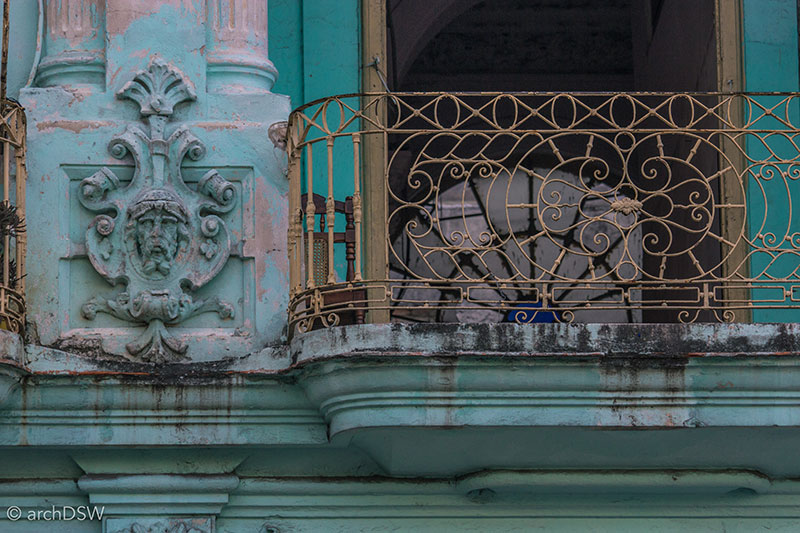


Figures 25-30. Although representative of distinctive styles and constructed in different eras, balconies, elevated walkways, grilles, and louvered panels for shade can be found throughout the city.
In many ways, Havana’s Necrópolis de Colón in Vedado (b. 1860s) serves as a microcosm for exploring much of the city’s diverse architectural landscape (Figure 31). Here, eclectic constructions fill the urban meter of major allées, tree-covered paths, and narrow, gate-lined entryways within Havana’s city for the dead (Figures 32–40).

Figure 31. Neo-romantic sculptures by José Villalta de Saavedra were added to the cemetery’s intricately carved gateway in 1904.

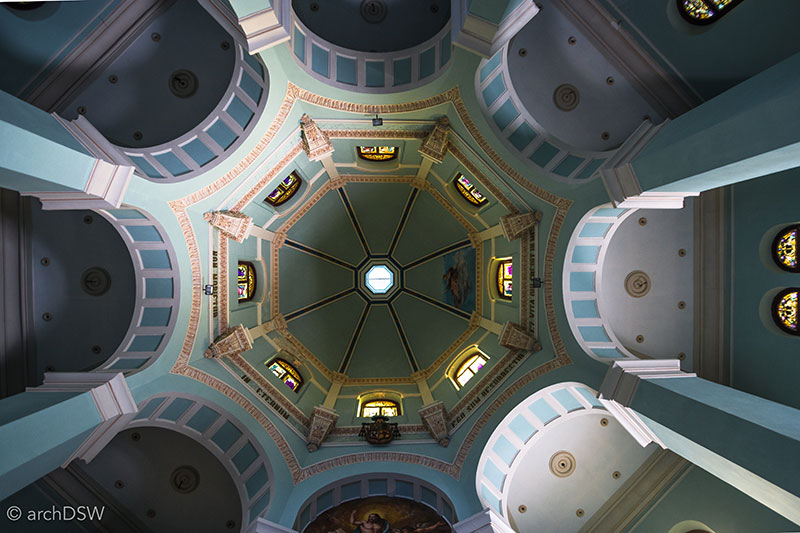
Figures 32 and 33. A chapel built in the late 1800s, resembling the Florence Duomo, sits at the center of the Avienda Colón and provides a point of orientation for navigating the large grid of the symmetrical complex.

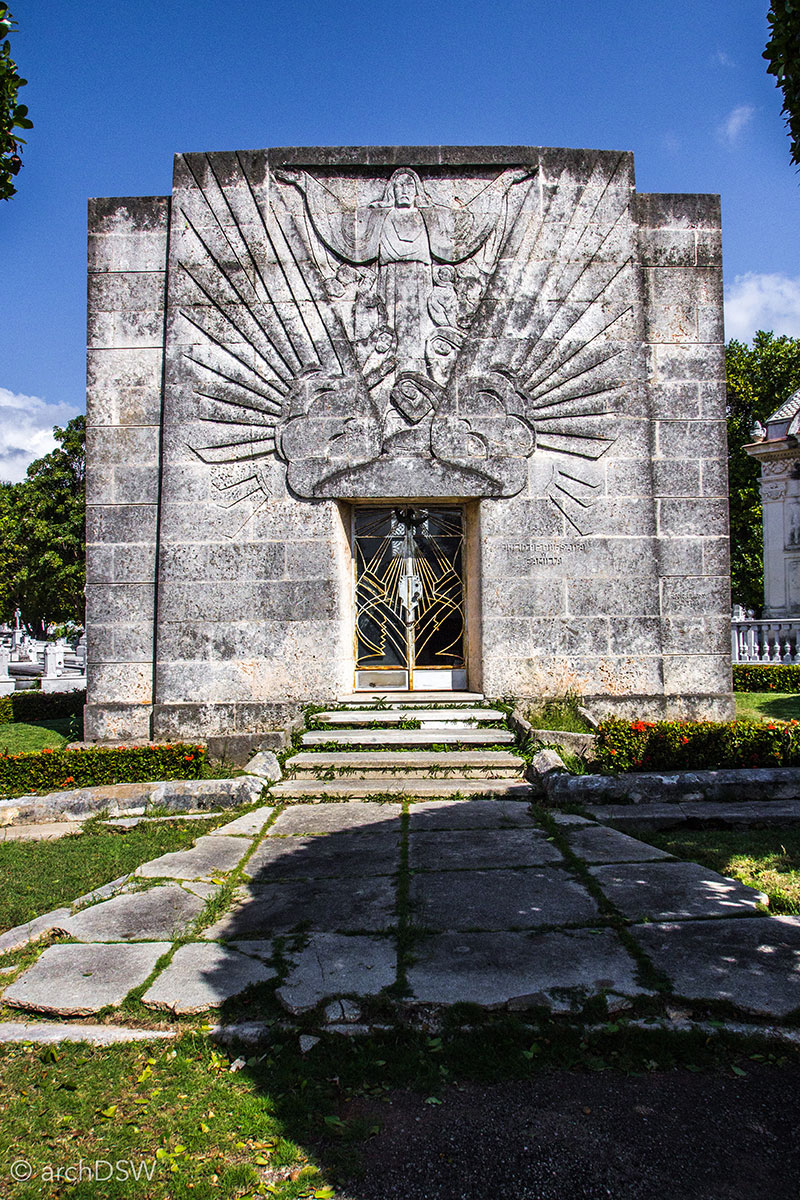

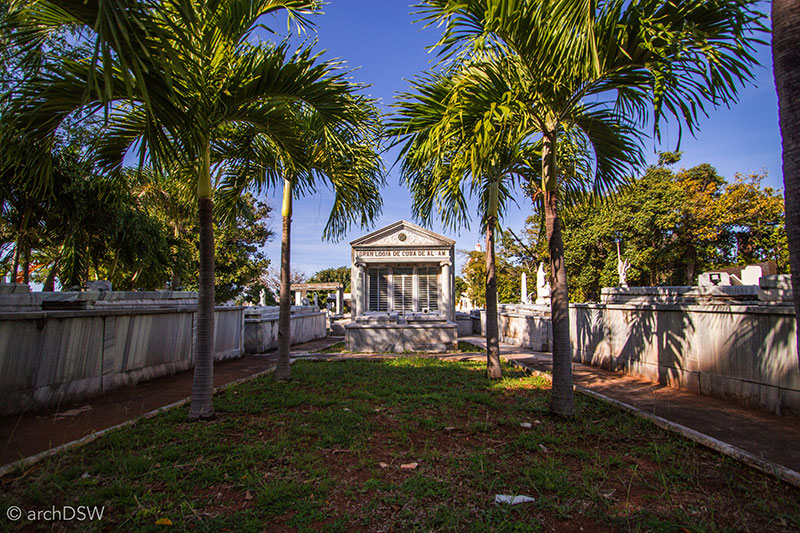

Figures 34-38. Monuments in the cemetery range from private tombs to family mausoleums to national monuments. Each construction has distinctive detailing, made from a palette of rich materials.
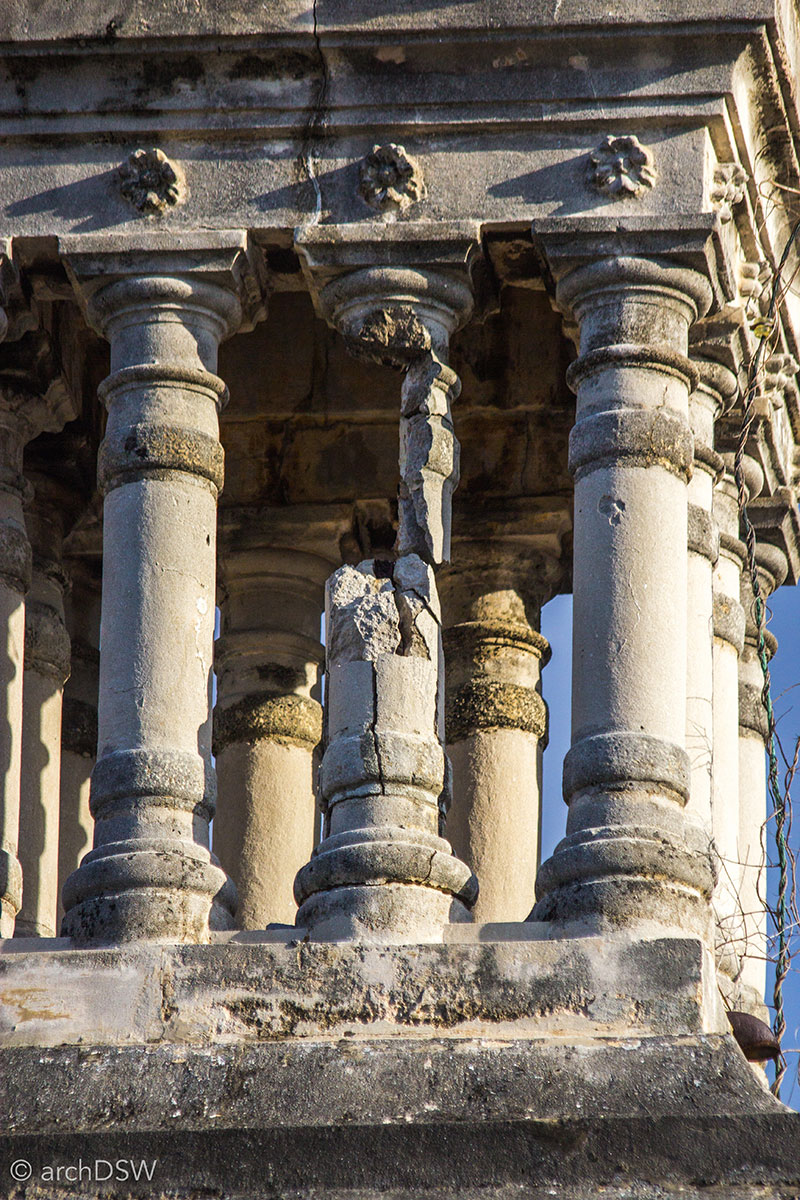

Figures 39 and 40. Although there are a substantial number of restoration projects underway, and a series of monuments that clearly have recently cleaned and stabilized, one can find crumbling tombs and statues throughout the necropolis.

Figure 41. As an impossibly thin and tent-like enclosure, the Núñez-Gálvez tomb (1957) was designed by Max Borges Recio and Enrique Borges is a glazed terracotta structure that anchors one of the cemetery’s circular nodes, connecting several allées, and the seemingly simple form actually conceals the weathered entrance to a subterranean tomb.

Figure 42. As one of the most distinctive structures in the cemetery, designed by Arnaldo Mesa, the Havana Reporters’ Association Mausoleum (1957) is in severe disrepair. The glazed parabolic structure, braced with an asymmetrical cross, now has warped steel pieces and shards of broken glass precariously hanging from weather-beaten frames. The chairs, mattresses, and clothing found in several of the worn, above ground mausoleums indicate that some of these structures now serve as temporary residences. This mausoleum, and several others, prevents inhabitation through the use of elaborate iron grates over stairs and subterranean entryways.
A Rapidly Aging City
In areas such as Vedado and Miramar, it is possible to fully perceive the two prominent building surges in Havana.3 The first era, spanning from 1914 to 1930, featured a stylistic sampling of Art Nouveau, Eclecticism, and Art Deco while the second period, from 1945 to 1960, focused on larger, urban projects with civic, educational, and mix use programs. The Revolution, largely, halted real estate speculation in the capital then the partnership with the Soviet Union stilted several governmentally funded projects that were distinctive as well as structurally and formally ambitious, characteristics counter to the architectural shift towards mass production and pre-fabrication. Perhaps the best known of these are the Cuban Schools of Art, also known as the Instituto Superior de Art, a site that will be explored in a future blog post.4 Located next to a military airfield in one of Havana’s western municipalities, the project receives select groups of architecturally inclined tourists but it is a site far afield for most visitors to the island.
The buildings completed in the twentieth century comprise 80% of Havana’s built fabric and although this massive surge in construction transformed the city, it also means that the vast majority of capital’s architecture is aging at the same rate, creating a city of residences and skyscrapers rapidly approaching ruin. Architectural deterioration is accelerated because of the humid climate, the island’s susceptibility to damage from coastal storms and hurricanes and, especially along the Malecón, the caustic effects of salinity (Figures 43 and 44; Video 3).

Figure 43. Several ruined buildings along the Malecón’s urban frontage have been removed to create parks and places for pop-up street festivals
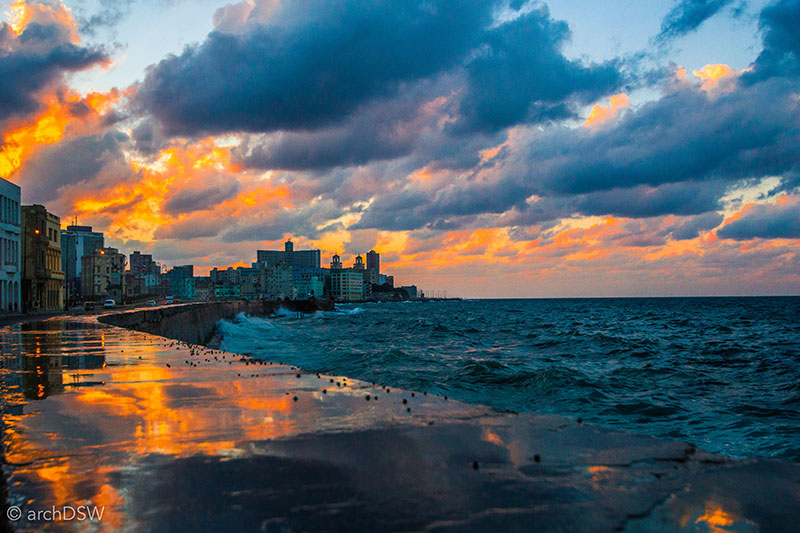
Figure 44. The restoration and reconstruction of a large portion of the Malecón in Central Habana just finished, however the seawall is perpetually battered by saltwater and subject to heavy pedestrian traffic.
Video 3. Sunset and street life along a newly restored section of the Malecón.
In portions of the capital, particularly around Central Habana, it is possible to experience architectural projects as full-scale representations of perspectival plans and sections: countless buildings, and even entire blocks, are crumbling (Figures 45–53). Although there are countless restoration efforts underway in Habana Vieja and privately initiated endeavors in Central Habana, there are a number of examples in the city of restoration projects that have been abandoned or adjusted. There are a number of sites where the rear portion of a building is missing but someone is carefully repairing the details and paint of the façade, like a colorful version of architectural makeup. At other sites, complex sets of wooden scaffolding have been abandoned and are now covered in vines, bringing new anterooms to the street and adding an urban paradise for birds as well as welcome resting places for the myriad stray dogs who seem to inhabit every shady swathe of space in the city (Figure 54).

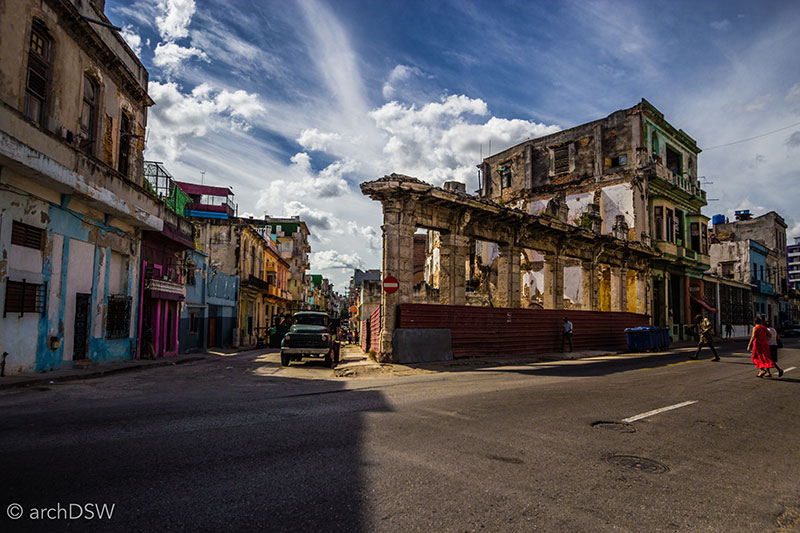
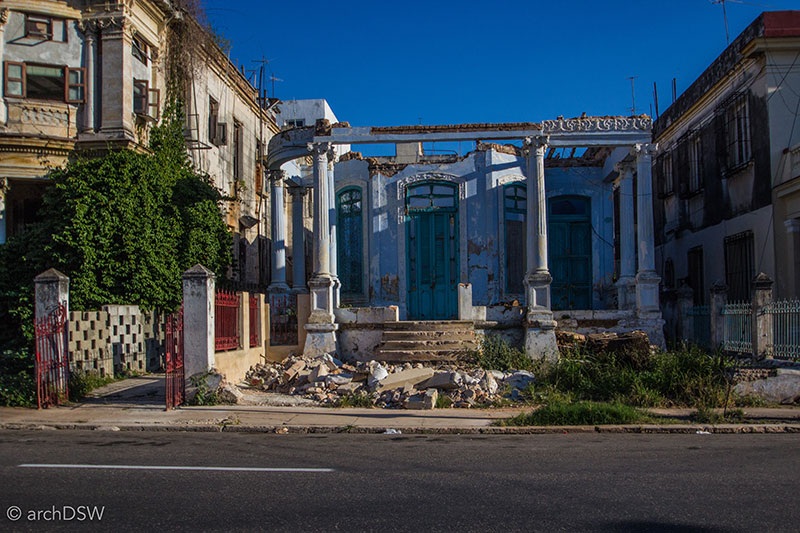




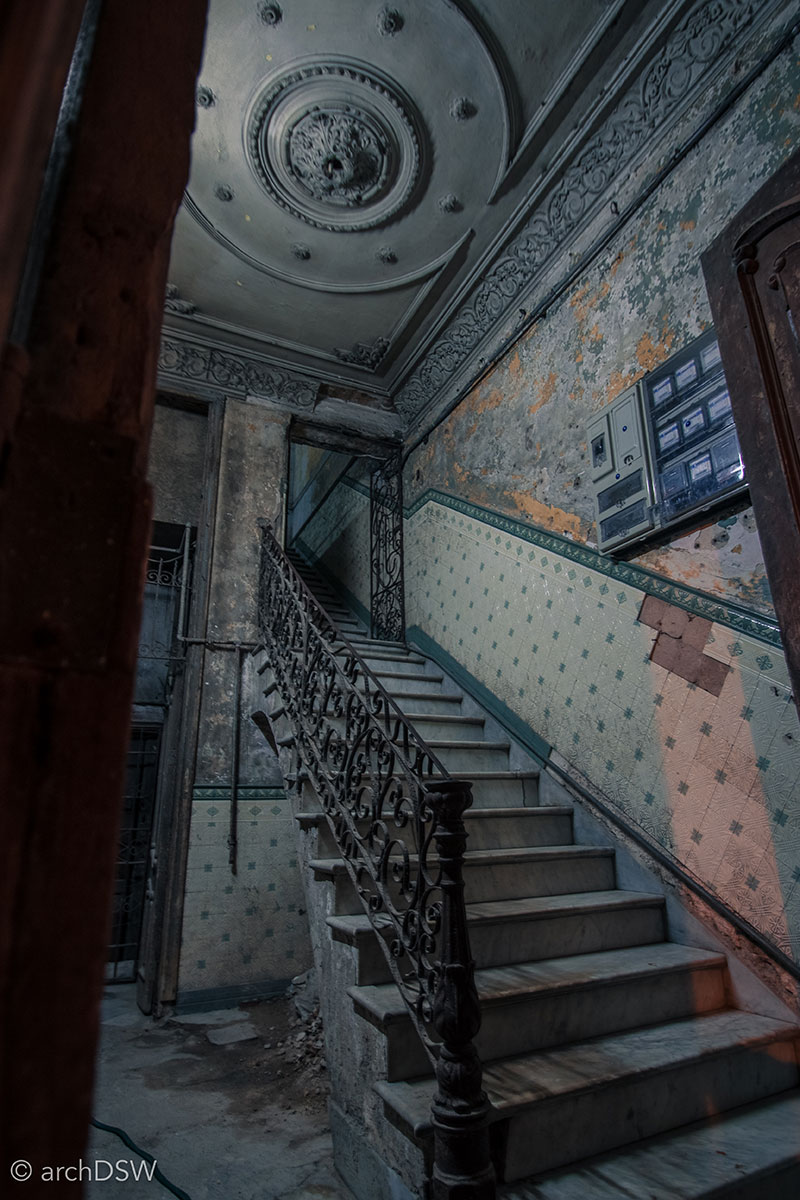
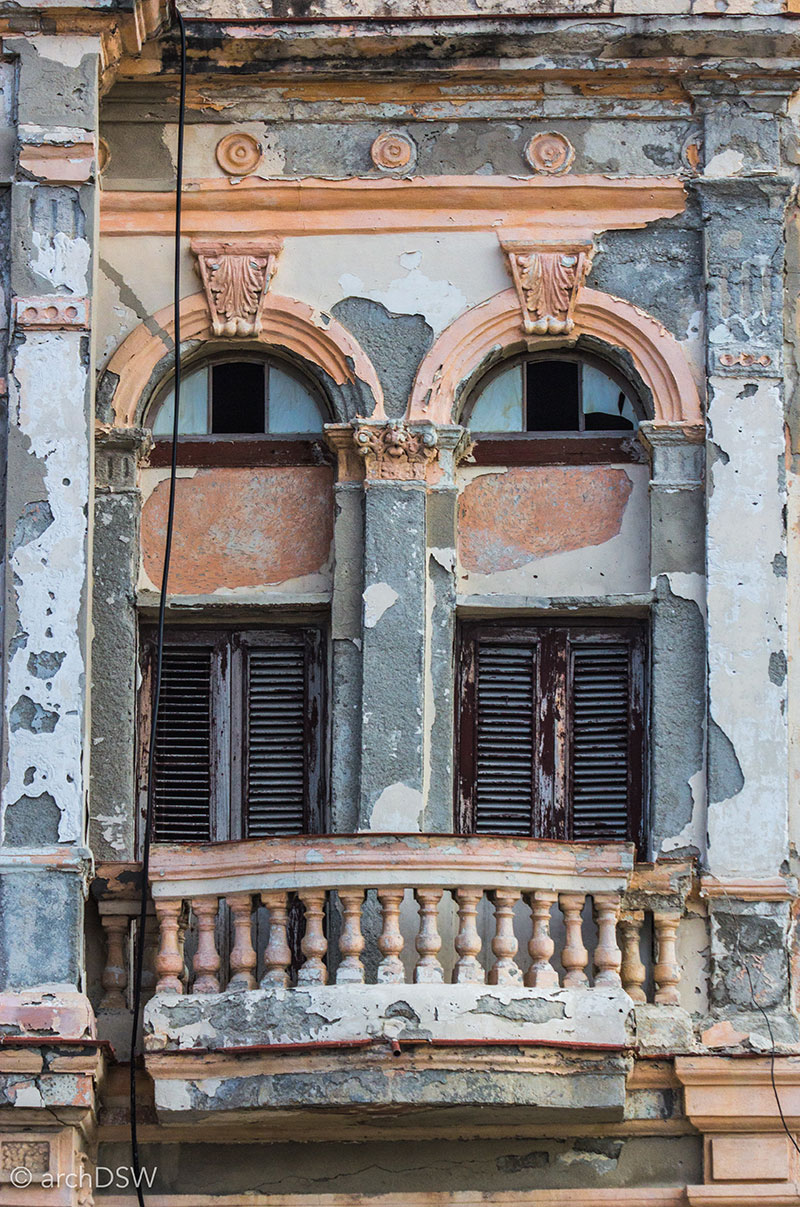
Figures 45-53. Scenes in Central Habana of eroded blocks, buildings, and roads. Despite these conditions, and the lack of an approved plan for restoration in this municipality, there is a vibrant community of residences and businesses.

Figure 54. Several sites around the city resemble the condition of this building’s shell, located hear the Capitolio, where nature has taken over.
With the embargo, few materials are available for citizens to maintain or restore residences but changes are underway that are due, in part, to new regulations for the nation’s real estate market. For the first time since the Revolution, citizens can buy and sell residences so ‘Se Vende’ [for sale] signs are now common sights on houses and apartment balconies in the capital (Figure 54).

Figure 55. The small ‘Se Vende’ sign is visible on the balcony. Housing can now be considered a personal asset in Cuba, allowing for a revived real estate market, but the state necessitates cash transactions.
Tuning In
While living in Havana, I discovered that one could be fully immersed in the layered complexities of the city. For tourists, it is a place where headphones must be entirely abandoned in order to enjoy the wonderful cacophony found throughout the city: dogs barking, jackhammers at work, street musicians playing bongos and singing, waves crashing on the Malecón, men ardently arguing about baseball in the parks, and the nonstop sounds from classic cars revving, honking, and sputtering through the streets. Havana’s history, architecturally and culturally, makes the city an exciting, bafflingly beautiful, and unpredictable place but it is also a city that can regularly test one’s patience and instill a profound appreciation for the maintenance of infrastructure as well as the availability of building materials and twenty-first technological connectivity (Videos 4 and 5).
Video 4. A deep rut along Dragones, south of the Capitolio, slows the classic cars and tests their already weary suspension systems. On many urban roads and even on the highways, lane markers tend to function merely as suggestions since drivers prefer to traverse the best preserved, or recently repaired, portions of the road. With large potholes and exposed base courses, many of the roads feel like obstacle courses but the Cuban drivers navigate with practiced ease.
Video 5. Sunset capture over Parque Central and the illumination of streetlights along the Paseo del Prado.
Recently, I had the privilege of traveling with the Soane Foundation, seeing some of Havana’s most treasured sites for art and architecture and meeting some of the city’s leading designers, historians, and preservationists. These encounters fully enforced that Havana is a city filled with architects, artists, educators, and policy makers who are eager to make connections and see the city restored. Simultaneously, they are cautiously optimistic about the changes and foreign investments linked to tourism.
In the next months, I will head farther afield and future blog posts will continue investigations initiated in Havana. As I navigate several other cities, some of the nation’s UNESCO World Heritage Sites, aspects of eco-tourism along the south and in several nature preserves, and the preservation efforts underway for the nation’s agro-industrial heritage, I look forward to exploring life in Cuba beyond the capital.
Bibliography
Carley, Rachel. Cuba: 400 Years of Architectural Heritage. New York, NY: Whitney Library of Design, 1997.
"Cuba's 2016 Mid-Year Tourism Figures Show Continued Strength." Cuba Journal, June 17 2016.
Griffith, Cathryn. Havana Revisited: An Architectural Heritage. Translated by Dick Cluster. New York, NY: W. W. Norton, 2010.
Loomis, John A. Revolution of Forms: Cuba's Forgotten Art Schools. New York, NY: Princeton Architectural Press, 2011.
Nahmias, Alysa, and Benjamin Murray. "Unfinished Spaces." 86 minutes. New York, NY: Ajna Films, 2011.
Niell, Paul. Urban Space as Heritage in Late Colonial Cuba. Austin, TX: University of Texas Press, 2015.
Reiter, Christiane, and Angelika Tasche, eds. Havana Style: Exteriors, Interiors, Details. Koln: Taschen, 2004.
Rodríguez, Eduardo Luis. The Havana Guide: Modern Architecture 1925–1965. New York, NY: Princeton Architectural Press, 2000.
———. "Integrating Vanguardisms: Dialogues between Art and Architecture Inmodern Cuba." In Beyond the Supersquare: Art & Architecture in Latin America after Modernism, edited by Antonio Sergio Bessa, 79–92: Forham University Press, 2014.
———. "Theory and Practice of Modern Regionalism in Cuba." Docomomo, no. 33 (2005).
Sapieha, Nicolas. Old Havana, Cuba. London: Tauris Parke Books, 1990.
1 For good overviews of Havana’s architectural history, from colonialism to modernism, see Rachel Carley, Cuba: 400 Years of Architectural Heritage (New York, NY: Whitney Library of Design, 1997); Cathryn Griffith, Havana Revisited: An Architectural Heritage, trans. Dick Cluster (New York, NY: W. W. Norton, 2010); Paul Niell, Urban Space as Heritage in Late Colonial Cuba (Austin, TX: University of Texas Press, 2015); Christiane Reiter and Angelika Tasche, eds., Havana Style: Exteriors, Interiors, Details (Koln: Taschen, 2004); Nicolas Sapieha, Old Havana, Cuba (London: Tauris Parke Books, 1990). The following texts provide a specific lens on the 20th century works: Eduardo Luis Rodríguez, "Integrating Vanguardisms: Dialogues between Art and Architecture Inmodern Cuba," in Beyond the Supersquare: Art & Architecture in Latin America after Modernism, ed. Antonio Sergio Bessa (Forham University Press, 2014); "Theory and Practice of Modern Regionalism in Cuba," Docomomo, no. 33 (2005); The Havana Guide: Modern Architecture 1925-1965 (New York, NY: Princeton Architectural Press, 2000).
2 "Cuba's 2016 Mid-Year Tourism Figures Show Continued Strength," Cuba Journal, June 17 2016.
3 For more on these eras and the politics behind the building surge, see the Introduction of The Havana Guide: Modern Architecture 1925–1965.
4 For a comprehensive history of the schools’ design and construction processes, and well as their stasis, see John A. Loomis, Revolution of Forms: Cuba's Forgotten Art Schools (New York, NY: Princeton Architectural Press, 2011); Alysa Nahmias and Benjamin Murray, "Unfinished Spaces," (New York, NY: Ajna Films, 2011).


Leave a commentOrder by
Newest on top Oldest on top